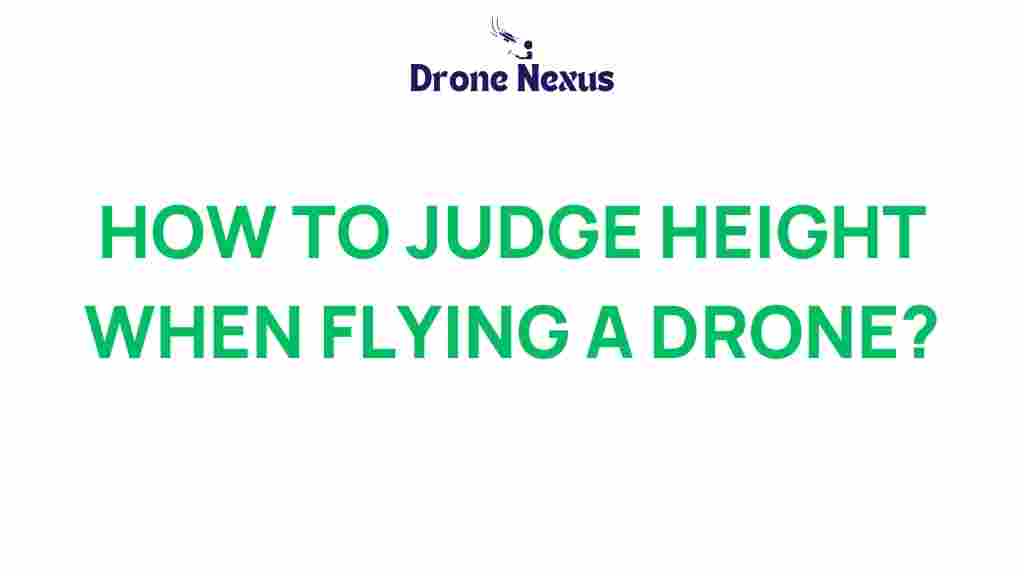Mastering Altitude: How to Judge Height When Flying a Drone
When it comes to drone flying, mastering altitude can significantly enhance your aerial photography, videography, and overall flight experience. Whether you’re a hobbyist or a professional drone pilot, understanding how to judge height accurately is crucial. In this article, we will explore various techniques and tools that can help you measure and maintain the correct altitude while flying your drone. You’ll also discover tips for troubleshooting common altitude-related issues. Let’s dive in!
Understanding Altitude in Drone Flying
Altitude refers to the height of your drone above sea level or ground level. When drone flying, altitude management is vital for several reasons:
- Safety: Maintaining a proper altitude helps avoid obstacles like trees, buildings, and other drones.
- Legal Compliance: Many regions have regulations governing maximum altitude limits for drones.
- Quality of Footage: Different altitudes can offer varied perspectives, impacting the quality of your aerial footage.
Types of Altitude Measurements
Before you start flying, it’s essential to understand the different types of altitude measurements:
- Absolute Altitude: The height of the drone above sea level.
- Relative Altitude: The height of the drone above the ground level directly beneath it.
- AGL (Above Ground Level): A specific term often used in drone flying to denote how high the drone is above the surface of the earth.
Step-by-Step Process to Judge Height When Flying a Drone
Now that you understand the importance of altitude, let’s look at how to judge height effectively while drone flying.
Step 1: Pre-Flight Planning
Before you take off, spend some time planning your flight. Consider the following:
- Research Local Regulations: Check the laws governing drone flight in your area, including altitude restrictions.
- Identify Flight Zones: Use apps or websites that provide information about no-fly zones and altitude limits.
- Assess the Environment: Look for potential obstacles that could affect your altitude, such as buildings or trees.
Step 2: Utilize Your Drone’s Built-in Altimeter
Most modern drones come equipped with altimeters that provide real-time altitude readings. Here’s how to use it:
- Locate the altimeter display on your drone’s controller or smartphone app.
- Monitor the readings continuously while drone flying to maintain your desired altitude.
- Understand the difference between absolute and relative altitude readings to make informed decisions.
Step 3: Use Visual References
While drone flying, visual references can be incredibly helpful. Here’s how to incorporate them:
- Identify landmarks or structures in your flight area.
- Use these references to gauge your drone’s height relative to the surroundings.
- Ensure that you maintain a safe distance from any objects while flying.
Step 4: Employ Altitude Hold Mode
If your drone has an altitude hold feature, utilize it for a more stable flight. This mode allows your drone to maintain a specific height without constant manual adjustments. Here’s how to enable it:
- Consult your drone’s manual for instructions on activating altitude hold mode.
- Set the desired altitude before takeoff.
- Monitor the drone’s altitude during flight to ensure it remains steady.
Step 5: Use GPS and Sensors
Many drones come equipped with GPS and various sensors that help maintain altitude. Here’s how to take advantage of these features:
- Check that your drone has a strong GPS signal before takeoff.
- Utilize onboard sensors, such as ultrasonic or barometric sensors, to enhance altitude accuracy.
- Familiarize yourself with how these sensors operate and their limitations.
Troubleshooting Altitude Issues When Drone Flying
Despite your best efforts, altitude issues can arise. Here are some common problems and how to troubleshoot them:
Problem 1: Inaccurate Altitude Readings
If you suspect that your drone’s altitude readings are inaccurate, consider the following:
- Calibration: Ensure that your drone is properly calibrated before each flight.
- Sensor Issues: Check for any damage to the sensors and clean them if necessary.
- Firmware Updates: Keep your drone’s firmware updated to ensure optimal performance.
Problem 2: Unstable Flight at a Set Altitude
If your drone struggles to maintain a steady altitude, try the following:
- Weight Distribution: Check that your drone isn’t overloaded with equipment.
- Battery Life: Ensure that your battery is adequately charged, as low power can affect stability.
- Weather Conditions: Avoid flying in windy or turbulent conditions that can destabilize your drone.
Problem 3: Loss of GPS Signal
If you lose GPS signal while drone flying, consider these tips:
- Find Open Spaces: Fly in areas with fewer obstructions that may interfere with GPS signals.
- Manual Control: Be prepared to switch to manual control if your drone loses GPS.
- Return to Home Feature: Use this feature if you cannot regain the GPS signal.
Conclusion
Mastering altitude is a critical skill in drone flying. By understanding the importance of altitude, utilizing your drone’s features, and applying practical techniques, you can ensure a safe and enjoyable flying experience. Regular practice and attention to detail will help you develop your judgment of height, allowing you to capture stunning aerial footage and navigate the skies with confidence.
For further reading on drone regulations and best practices in your area, visit the Federal Aviation Administration (FAA). Additionally, check out our comprehensive guide on drone accessories to enhance your flying experience!
This article is in the category Applications and created by DroneNexus Team
